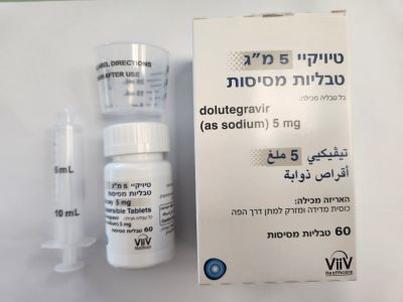Quest for the right Drug

טיויקיי 5 מ"ג טבליות מסיסות TIVICAY 5 MG DISPERSIBLE TABLETS (DOLUTEGRAVIR AS SODIUM)
תרופה במרשם
תרופה בסל
נרקוטיקה
ציטוטוקסיקה
צורת מתן:
פומי : PER OS
צורת מינון:
אין פרטים : DISPERSIBLE TABLETS
עלון לרופא
מינוניםPosology התוויות
Indications תופעות לוואי
Adverse reactions התוויות נגד
Contraindications אינטראקציות
Interactions מינון יתר
Overdose הריון/הנקה
Pregnancy & Lactation אוכלוסיות מיוחדות
Special populations תכונות פרמקולוגיות
Pharmacological properties מידע רוקחי
Pharmaceutical particulars אזהרת שימוש
Special Warning עלון לרופא
Physicians Leaflet
Pregnancy & Lactation : הריון/הנקה
4.6 Fertility, pregnancy and lactation Women of childbearing potential Women of childbearing potential (WOCBP) should be counselled about the potential risk of neural tube defects with dolutegravir (see below), including consideration of effective contraceptive measures. If a woman plans pregnancy, the benefits and the risks of continuing treatment with dolutegravir should be discussed with the patient. Pregnancy Human experience from a birth outcome surveillance study in Botswana shows a small increase of neural tube defects; 7 cases in 3,591 deliveries (0.19%; 95% CI 0.09%, 0.40%) to mothers taking dolutegravir- containing regimens at the time of conception compared to 21 cases in 19,361 deliveries (0.11%: 95% CI 0.07%, 0.17%) to women exposed to non-dolutegravir regimens at the time of conception. The incidence of neural tube defects in the general population ranges from 0.5-1 case per 1,000 live births (0.05-0.1%). Most neural tube defects occur within the first 4 weeks of embryonic development after conception (approximately 6 weeks after the last menstrual period). If a pregnancy is confirmed in the first trimester while on dolutegravir, the benefits and risks of continuing dolutegravir versus switching to another antiretroviral regimen should be discussed with the patient taking the gestational age and the critical time period of neural tube defect development into account. Data analysed from the Antiretroviral Pregnancy Registry do not indicate an increased risk of major birth defects in over 600 women exposed to dolutegravir during pregnancy but are currently insufficient to address the risk of neural tube defects. In animal reproductive toxicity studies, no adverse development outcomes, including neural tube defects, were identified (see section 5.3). More than 1000 outcomes from exposure during second and third trimester of pregnancy indicate no evidence of increased risk of foetal/neonatal toxicity. Dolutegravir may be used during the second and third trimester of pregnancy when the expected benefit justifies the potential risk to the foetus. Dolutegravir crosses the placenta in humans. In pregnant women living with HIV, the median foetal umbilical cord concentration of dolutegravir was approximately 1.3-fold greater compared with the maternal peripheral plasma concentration. There is insufficient information on the effects of dolutegravir on neonates. Breast-feeding Dolutegravir is excreted in human milk in small amounts (a median dolutegravir breast milk to maternal plasma ratio of 0.033 has been shown). There is insufficient information on the effects of dolutegravir in neonates/infants. It is recommended that women living with HIV do not breast-feed their infants in order to avoid transmission of HIV. Fertility There are no data on the effects of dolutegravir on human male or female fertility. Animal studies indicate no effects of dolutegravir on male or female fertility (see section 5.3).

פרטי מסגרת הכללה בסל
א. התרופה תינתן לטיפול בנשא HIV.ב. מתן התרופה ייעשה לפי מרשם של מנהל מרפאה לטיפול באיידס במוסד רפואי שהמנהל הכיר בו כמרכז AIDS;ג. משטר הטיפול בתרופה יהיה כפוף להנחיות המנהל כפי שיעודכנו מזמן לזמן על פי המידע העדכני בתחום הטיפול במחלה.
שימוש לפי פנקס קופ''ח כללית 1994
לא צוין
תאריך הכללה מקורי בסל
12/01/2014
הגבלות
תרופה מוגבלת לרישום ע'י רופא מומחה או הגבלה אחרת
מידע נוסף
